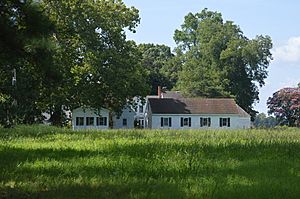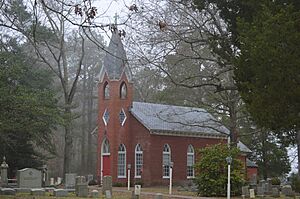Sally Louisa Tompkins facts for kids
Sally Louisa Tompkins (born November 9, 1833 – died July 25, 1916) was an amazing woman who helped many people. She was a nurse and a kind person who gave money to good causes. Sally was the first woman to officially join an army in American history. Many people think she was also the only woman to become an officer in the Confederate Army. She is best known for opening her own hospital in Richmond, Virginia. This hospital treated soldiers who were hurt during the American Civil War. Under her care, her hospital had the lowest number of deaths of any hospital during the war. People called her the "Angel of the Confederacy."
Contents
Sally's Early Life
Sally Tompkins was born at a place called Poplar Grove in Virginia. She was the youngest of eight children. Her father, Colonel Christopher Tompkins, was a very rich businessman. He died when Sally was almost five years old.
Sally was very close to her older sister, Elizabeth. Elizabeth helped fix up their local church, Christ Church. Sadly, in 1842, three of Sally's sisters (Martha, Harriet, and Elizabeth) died from a sickness. This was a very hard time for Sally. Even though she had a difficult childhood, Sally found a way to help others. She nursed sick people in her community, both free people and enslaved people.
We don't know a lot about Sally's early years because many records are missing. We do know that Sally, her mother, and her sister Maria lived in Norfolk, Virginia, from 1849 to 1852. While there, Sally and Maria studied at the Norfolk Female Institute. In 1854, they moved to Richmond, Virginia. Sally's mother died a few months later. The Tompkins family had done business in Richmond for many years, so Sally and her sister were welcomed. They rented rooms in the city, not knowing that Richmond would soon be a very important place in the Civil War.
The Angel of the Confederacy
Richmond became the capital city of the Confederacy in April 1861. At first, everyone thought the war would end quickly. But after the first big battle, people realized it would be a long and hard fight.
The First Battle of Bull Run happened on July 21, 1861. It was a victory for the South, but it also showed how terrible the war would be. Hundreds of wounded soldiers poured into Richmond. The city was not ready for so many injured people. Official hospitals quickly filled up. Factories, churches, and even homes became temporary hospitals.
Sally Tompkins, who was almost 28 years old, was one of the people who stepped up to help. She opened Judge John Robertson's home as a hospital. Judge Robertson had left his home for Sally to use while his family was away. Sally was not alone in this effort. Many women from Saint James Episcopal Church, along with some enslaved people, helped run what became known as Robertson Hospital. This hospital became one of the biggest wartime hospitals in the South.
After the first rush of wounded soldiers, Confederate President Jefferson Davis made a rule. He said that all military hospitals had to be run by the military. Robertson Hospital was doing such good work that President Davis wanted it to continue. So, he made Sally Tompkins a captain in the Confederate Army. This meant she could keep running her hospital. She was one of the first women to become an officer in the Confederate States Army. Sally refused to take any money for her work. On her military paper, dated September 9, 1861, she wrote that she accepted the rank but would not take any pay.
Robertson Hospital treated patients throughout the entire war. It closed its doors on June 13, 1865. During its four years, the hospital treated 1,334 wounded soldiers. Only seventy-three of them died. This was the lowest death rate of any military hospital during the Civil War. A famous writer named Mary Chesnut often visited the hospital. She wrote that Sally Tompkins was "Our Florence Nightingale," comparing her to the famous nurse. Another volunteer, Judith McGuire, wrote about her experiences nursing patients there.
Running a hospital was not easy. Richmond relied on goods brought in from other places. When the Union Navy blocked the coast, it was hard to get supplies. The city even had riots because of the lack of food. When supplies were hard to find in Richmond, Robertson Hospital hired a special ship to bring in things from other countries.
Sally and the other women stayed at the hospital throughout the war. They earned the love and respect of their patients. Even though Sally was not focused on looks, many former patients asked her to marry them because they were so grateful. She said no to all of them. More than 1,300 men who were lucky enough to be sent to Robertson Hospital simply called her "Captain Sally."
Life After the War
When Richmond was left empty in April 1865, Sally and some volunteers chose to stay at the hospital. They wanted to treat the last patients. Sally talked with the Union medical director, and he allowed her to keep her hospital open for two more months after the war ended.
Once the hospital finally closed, Sally traveled around Virginia. She visited old friends and family. She also volunteered to teach Sunday school at St. James Episcopal Church and was an active member there for most of her life.
Sally was a local hero in Richmond. In 1896, she hosted a reunion for her former patients. Veterans traveled from far away to thank the kind lady who had saved their lives so many years before. She never married and continued to do charity work for many years. Eventually, Sally's family money ran out. In 1905, she went to live in the Confederate Women's Home as an honored guest.
Death and Lasting Impact
Sally Tompkins died in 1916. She was buried with full military honors at Christ Church in Mathews County. Sally is remembered alongside other important women like Clara Barton. These women helped during the Civil War, especially after the Battle of First Bull Run, when the terrible reality of war became clear. They helped make nursing the skilled job it is today. Sally Tompkins was very focused on cleanliness, which led to better hygiene in hospitals. Her low death rates show how important her practices were. These ideas are still used by doctors and nurses everywhere.
Many monuments remember Captain Sally and Robertson Hospital. In 1910, Sally helped unveil a marker where Robertson Hospital once stood. The marker is still there today, but the original hospital building is gone. The spot is now a diner. There are also historical markers in her hometown that tell about her life.
In the 1960s, during the Civil War Centennial, people tried to honor Captain Sally. One way was a beautiful stained glass window in St. James Episcopal Church. It shows Captain Sally with an angel watching over her. There was also a plan to put a statue of Captain Sally on Monument Avenue in Richmond. However, the famous artist Salvador Dalí designed the statue, and his design caused a lot of anger in the city. So, the statue was never built.
Three groups of the United Daughters of the Confederacy are named after Captain Sally. She was made an Honorary President of the Virginia Division in 1905. One of these groups was started in her hometown of Mathews, Virginia, in 1908. It was called the Captain Sallie Tompkins Chapter, but her name was misspelled. This group closed in 1955.
In 1999, a newspaper article led to a new group forming in Mathews. Since Sally's name was misspelled in the old group's name, they started a new chapter. This new chapter officially began on August 22, 2000.
So far, two books have been written about Captain Sally's life. One is a book of poems called Dearest of Captains. The other is a biography written by a distant relative of Sally's, called The Lady With the Milk White Hands.
Sally Tompkins was the aunt of a painter named Clementina Tompkins.
Images for kids





